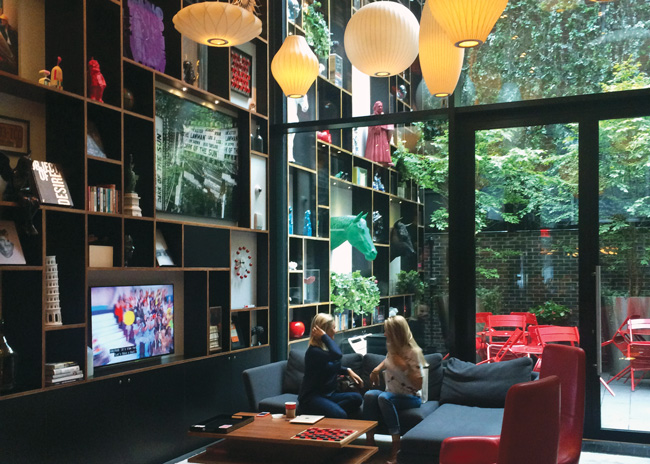Patent Coffee/Patent Pending
New York City
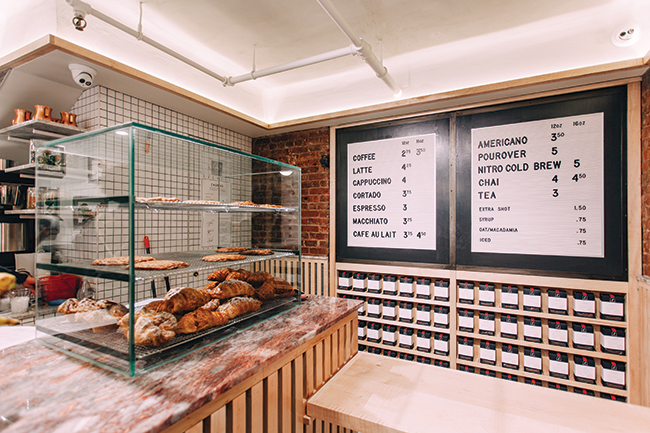 Images courtesy of Simmer Group
Images courtesy of Simmer Group
Patent Coffee in the NoMad district is bright and sleek, with white and gray tiles, light poplar wood, lots of straight lines and a brick wall original to the building along one side. It’s crisp and clean with fresh flowers in frames alongside the counter.
But there’s a different world to Patent. Come 4 p.m., the coffee shop closes and the doors are locked. An hour later, the venue starts welcoming guests back in — for cocktails and dinner. There’s no sign outside announcing this: You have to be in the know.
Evening guests are allowed into the coffee shop via a buzzer and then enter the darkened space — now lit by candles — where the hostess awaits. Guests are guided toward a dark hallway via a door that is concealed during the day. Pre-war tiles from the original building line the hallway floor from the coffee shop “because we wanted people to feel transported in time,” says owner Ryan McKenzie, “and we’re trying to keep an antique vibe for the place without it feeling cliched.” Along the hallway, lanterns cast a dim light. Copies of some of Tesla’s patents, as well as pictures of old cocktail patents, adorn the walls.
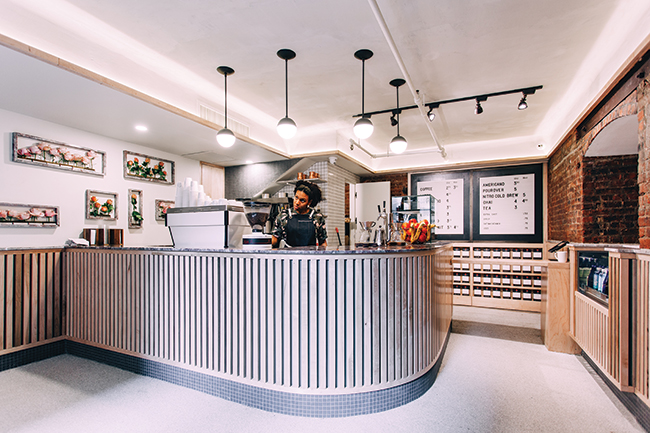
At the end of the hall is Patent Pending, a 34-seat speakeasy-style bar that takes full advantage of the building’s arched brickwork to create a cave-like atmosphere. Dark wood is used throughout, and there’s a metal cage containing booze above the bar, as well as bird cages and naked lightbulbs.
McKenzie, who opened Patent in January, deliberately didn’t want crossover of these two concepts “because people don’t want to drink coffee in a cocktail bar or cocktails in a coffee shop.” Also, it’s hard to do that operationally, he says, “and it would have ruined the experience of walking through the candlelit coffee shop.”
McKenzie loves the contrast between the front, which makes up about 30 percent of the space, and the back. “The coffee shop creates a plot twist — it sets it up. It’s fun to see people’s faces when they see the menu board open up.”
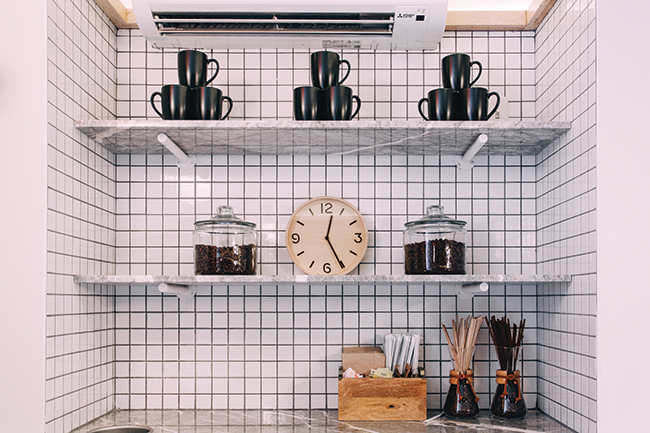
Trust
St. Louis, Mo.
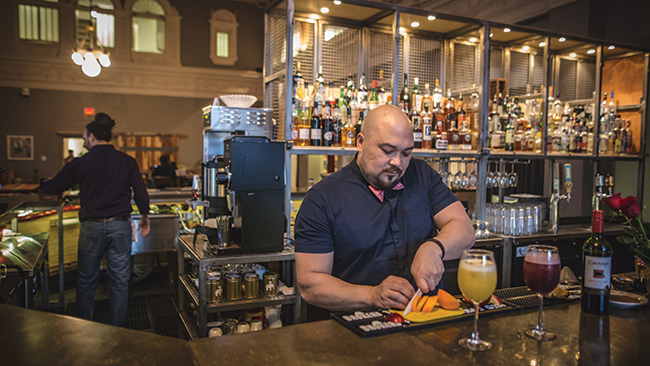 Images courtesy of Trust
Images courtesy of Trust
Trust takes a different approach — and is still experimenting with the best way to balance the coffee and cocktails. Located in the Beaux Arts-style restored Mississippi Valley Trust Company building that dates to 1896, Trust keeps the focus on its U-shaped bar, which serves coffee and pastries from 8 a.m. to 4 p.m. and cocktails from 4 p.m. to close.
Both options can be seen from the window, “but the challenge is putting them both up front without them conflicting,” says Chief Operating Officer and Founder Daniel Brian.
Tweaking the concept, which has been open less than a year, has meant lowering the backbar, which serves as both storage and a barista station. Brian also recently moved the espresso machine’s placement from the bar to the backbar to make it more convenient for morning baristas to clean and have a view of guests.
Moving the machine also means that, at night, the bar top is an uninterrupted space and guests can sit along the full length. This is better for revenue, Brian says, and so far, the bar has been bringing in around 75 percent of revenue, both because it has more patrons and because the drinks are more expensive. In fact, since he’s moved the espresso machine, “the bar can now do more than $1,000 per hour easily; before, it was a struggle to do that.”
Operating two locations in one, Brian says, “is always a compromise.” The downside of moving the espresso machine is that it adds a few steps for the baristas.
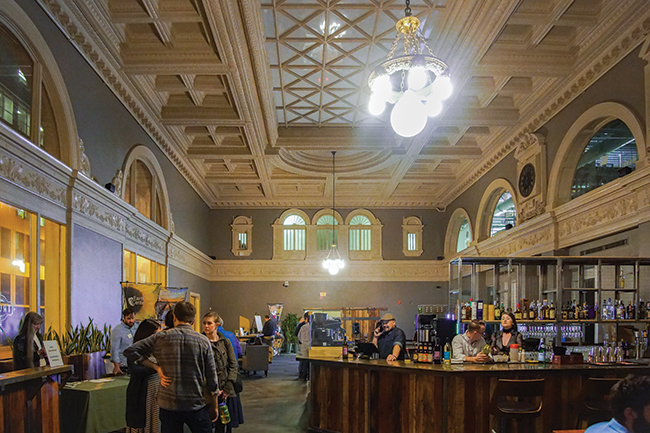
To change the atmosphere from day to night, Brian made sure he could change the lighting. Curtains close in the evening, lights dim and the music volume rises.
The only thing that’s a real challenge to change, Brian says, are the eight two-top tables at the front of the bar. “At a coffee shop, people like to sit at a low table, but at a bar, they like a high table because they’re at the level of the bar, especially if they have people standing around them.”
Brian is considering switching from low to high tables but doesn’t want to do this too soon. “It takes 18 months to get a coffee shop established, but it’s much quicker with a bar. So, I don’t want to move things over too much to the bar because we’re still finding our feet with coffee,” he explains.
The rest of the decor works for both concepts, Brian says. “People want soft seating in bars and coffee shops. They will spill more in a bar, so you want to think of stainability of fabrics, but spills happen in coffee shops, too.”
Trust is a spinoff of Brian’s original Trust in San Francisco. The biggest difference between the two, he says, is that he moved the bar up front; in San Francisco, it’s much deeper into the space. “There, we have a great coffee shop, which is doing incredibly well, and a very quiet bar that our members use (both are co-working spaces). If it was just a bar, it would be in a lot of trouble, but luckily, we have a very active events program there.”
Trust has opted to discontinue coffee service.
The Henry
Los Angeles
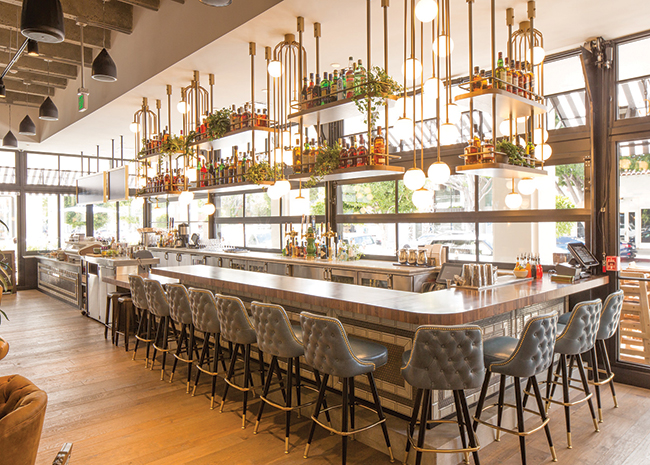 Images courtesy of Fox Restaurant Concepts
Images courtesy of Fox Restaurant Concepts
The tagline for The Henry in Los Angeles is “the greatest neighborhood restaurant,” so when it was being designed, Fox Restaurant Group’s founder and CEO Sam Fox knew it had to deliver.
Fox’s intentions were to create “a community space that would be used differently than a typical lunch and dinner spot — a restaurant that needed to seamlessly transition from day into night,” he says.
“I wanted it to feel warm and welcoming, so I probably overthought every detail,” Fox says. “When it was all said and done, we created a space that was comfortable and approachable for the morning crowd while also upscale and elegant enough for the diners going into the evening.”
The Henry’s day starts with coffee and pastries and ends with dinner and cocktails. All of these — plus lunch, brunch and anything in between — are served in a large, elegant restaurant with an open feel but outfitted with different furniture in areas creating zones: smaller spaces within the overall space.
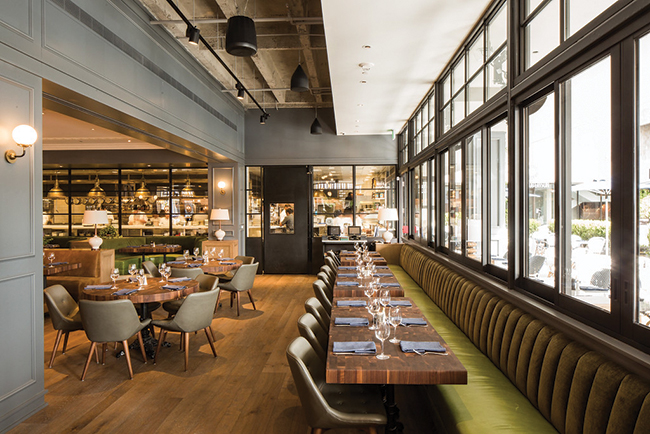
Lots of greenery brings the place alive, and the energy travels around freely from the coffee and pastry area, with its clean lines, to the green leather and suede banquettes in the dining room to the more casual area next to a wall of pop culture magazines.
Because this space was designed to be used from dawn until way past dusk, Fox wanted it to feel different depending on daypart. In the morning, the focus, naturally, is on the coffee bar. Guests tend to congregate there as well as the adjacent lounge areas and at communal tables. For lunch and dinner, however, hosts seat diners in the main dining room, which naturally pulls people away from the coffee bar — though it’s still open.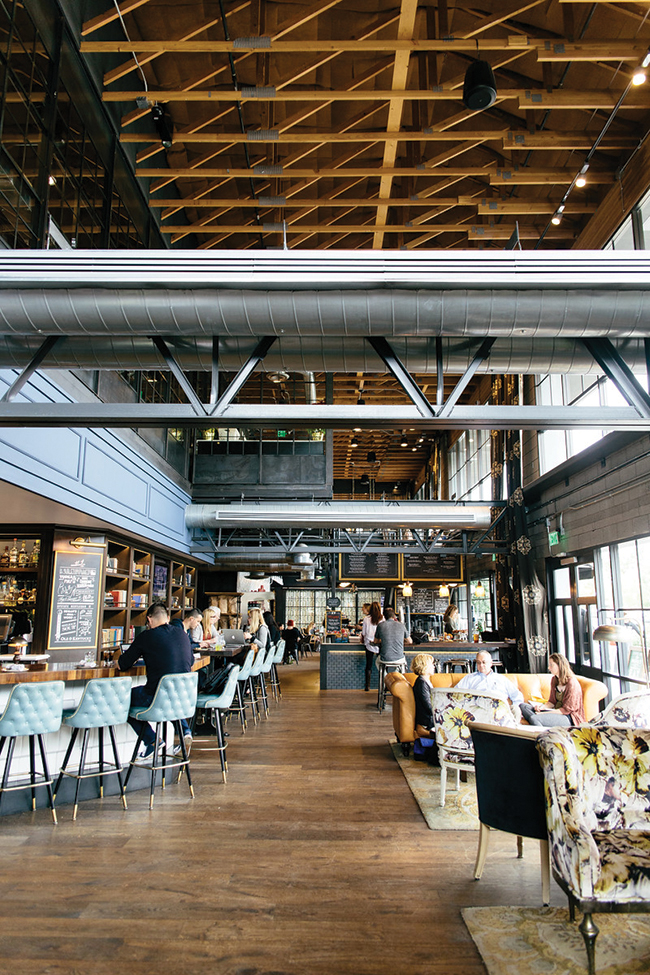
At night, the bar is highlighted — and it’s worth looking at — with greenery and cascading globe lights. The open kitchen allows the energy to flow into the dining room during lunch and dinner while also giving guests a glimpse of the nighttime action.
To emphasize the change, natural light pours into The Henry through large floor-to-ceiling windows during the day, and the music is calmer for coffee drinkers still trying to wake up. In the evening, the manager dims the lights, turns on the patio string lights and gets the outdoor fireplace going.

